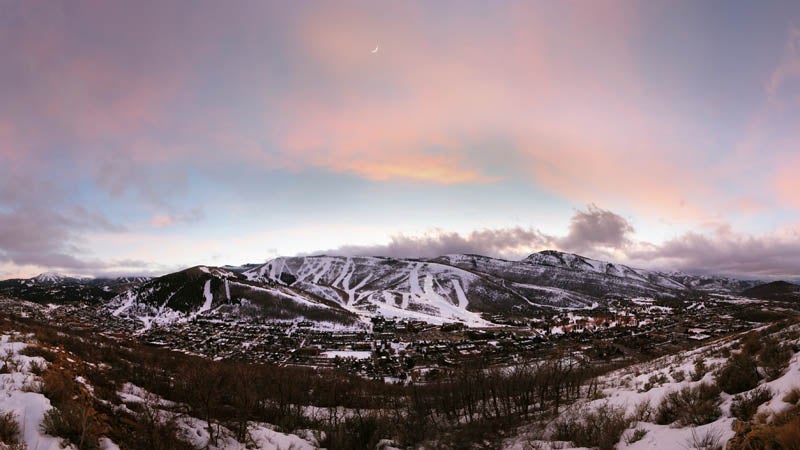It’s rare that the blanched, distended underbelly of the corporate ski industry gets exposed to the skiing public, but that’s exactly what’s been happening for the past three seasons in the mountains above Park City, Utah. If you don’t read Bloomberg or own a major piece of Vail Resorts, you might not have been paying attention. Here’s an easily digestible overview.
Unlike most big ski areas in North America, —the ski area whose runs flow directly into the town of Park City—operates almost entirely on private land. PCMR owns the land at the base. A company named Talisker Corporation owns much of the rest: the important stuff with the lifts, snowfall, and the inclines that make for fun with gravity.
Until recently, Talisker also operated —the second of the three greater Park City area resorts that sits just to the northwest of PCMR. That was the status quo until March 2011 when, in Ivy League MBA terms, “somebody effed up, yo.”
That’s when PCMR failed to send in the paperwork and renew its sweetheart terms on the land it leased from Talisker. Sweetheart deal is no understated cliché here. The terms dated back to the 1970s and gave PCMR full use of the land—around 3,500 acres—for $150,000 a year. It was widely considered by industry insiders to be the best lease in the ski business.
Imagine if you had a rent-controlled apartment in Manhattan and the only thing you had to do to keep it was pay your pittance of rent on time and occasionally send in some paperwork saying you wanted to maintain the arrangement for the next 20 years. For reasons that remain unclear—the company says it was an honest mistake—PCMR was late to do that. Too late it turns out.
That’s when skiing showed its . PCMR, understandably if a bit like a college student with a late term paper, attempted to cover up its misstep by post-dating the paperwork. Talisker, which isn’t really a ski resort operations company but long understood the value of the land PCMR was renting, promptly sold the operating lease of Canyons to Vail Resorts—the largest ski resort company in North America.Ěý
Unless you like riding lifts and contouring more than skiing the fall line, you would never traverse the extent of the mega ski area in a day. It’s too spread out: one PCMR plus one Canyons does not a Chamonix make.
Vail Resorts, by all accounts, overpaid for Canyons lease ($25 million plus a percentage of revenue), knowing that after some legal wrangling on behalf of Talisker it would soon be in control of both the PCMR property andĚýCanyons, which when combined (one lift would do it) would result in a mega resort of 7,500 plus acres.
And that——is pretty much where we’re at now. Talisker has the right to lease the land it owns to Vail Resorts. And PCMR has a choice: Deploy a nuclear option and remove the lifts and disallow access from the private land it owns at the base. (The company’s ) Or sell its infrastructure and base-area operating rights to Vail Resorts.
It seems like a tale of a huge publicly-traded corporation beating up on a sleepy mom-and-pop operator, but despite the mudslinging to that effect, that’s not really the case. Talisker is the largest landowner and developer in Park City and more recently has invested heavily in luxury gated communities and five-star restaurants. And the money behind or at least associated with —the operating company that owns PCMR as well as a slew of other ski areas—also counts its dollars in the billions.
It’s hard to have much empathy for any of the players. And really we shouldn’t bother. It’s just business. And more importantly, the foundation of business in a free society: contract law. If this deal had gone down in Putin’s Russia, one of the players would have bought off the government at great expense. Here, the broken contract abides.
So what does it all mean for skiers? A lot if you’re a dedicated buyer with a mind to ski Utah. Sometime in the next season or two—after the appeals have made the corporate lawyers rich and barring that bizarre but theoretically possible nuclear option—it’s almost certain that Vail Resorts will be operating a rebranded supersized Park City ski area that you’ll be able to ski on the insanely affordable Epic Pass.
The combined resorts will offer more than enough terrain and amenities to entice destination skiers for longer visits. Vail Resorts will do well off this deal. It doesn’t just get that corporation a foothold in the growing Utah market, it makes it the biggest player in the state.
But how does the new mega resort stack up for purists only interested in Utah’s famous steep-and-deep skiing? For that set, this is a much-ado-about-nothing deal. Canyons is an aptly named resort. The skiing lays out in a maze-like array of drainages and sub-peaks. There’s tremendous 45-degree north-facing terrain in the jumble as well as a handful of longer full-throttle groomers worthy of downhill speeds, but most of the shots are short of vertical drop and it takes a lot of time to move from canyon to canyon.
The fact that Canyons and PCMR are the subject of such heated debate speaks to the changing dynamics of the ski business where broad-ranging season pass deals outweigh the sale of individual lift tickets.
That’s why most advanced skiers head to the Ninety-Nine 90 lift and stay there, just as they congregate at the McKonkey’s or Jupiter Bowls on the Park City side. Adding the multi-summit PCMR terrain to Canyons means upwards of 14 drainages and nearly as many summits and lesser peaks over those 7,500 acres. Unless you like riding lifts and contouring more than skiing the fall line, you would never traverse the extent of the mega ski area in a day. It’s too spread out: one PCMR plus one Canyons does not a Chamonix make.
The fact that Canyons and PCMR are the subject of such heated debate, however, speaks to the changing dynamics of the ski business where broad-ranging season pass deals now outweigh the sale of individual lift tickets. The idea is to lock in as many skiers as possible to your brand.
The controversy is also emblematic of the growing value of Utah as a ski destination. Vail Resorts’ holdings in Colorado alone see more skier visits than the entire Beehive State, but Utah skiing has grown steadily since before the 2002 Olympic Games, largely due to ample snowfall and perhaps the easiest access in the sport. Those seven Wasatch resorts are—no hype—within 45 minutes of Salt Lake’s airport. As comparison, try to get to a major destination resort from Denver International along the ever-busier I-70 corridor on a weekend in less than three-hours. (Bring lunch.)
Then there’s Ski Utah’sĚýOne Wasatch concept. Their goal is to connect the seven resorts of the Wasatch Front with lifts and runs, letting skiersĚýaccess 18,000 acres and 100 chairlifts with just one pass.ĚýThat idea has raised the ire of backcountry skiers and environmentalists, but connecting Canyons with PCMR is not something anyone would bother fighting. As for the tram basing out of a combined PCMR/Canyons resort, which was proposed back in 2012 and would have linked to Solitude, why would Vail Resorts send its skiers to another mountain? The short answer is they won’t. The so-called Ski Link idea has been officially “tabled” by Canyons, and it’s no longer a proposal. Phew.
As a publicly-traded, for-profit business, Vail Resorts has to act in its own best interests and the best interests of its shareholders. And that speaks to the other oft-vocalized concern about Vail Resorts moving to town. In Colorado, Vail pulled out of the trade association years ago. The undisputed leader in the season pass war, their strategy is to brand, promote, and ultimately sell the Epic Pass. It’s difficult to see how pushing the One Wasatch agenda helps that cause.
For now, the matter goes back to the courts for an appeal process that is expected to take up to a year. All sides have promised that PCMR will be operational during the legal battle. That would be hugely beneficial to the players it’s easy to empathize with: the lifties, fry cooks, ski patrollers, shop technicians, and waiters who call the great town of Park City home and probably like being employed—when it’s not a powder day anyway. In °żłÜłŮ˛őľ±»ĺ±đ’s role as an observer of the ski industry and a supporter of the skiing public, we’d like to see that promise kept—as the contract lawyers bluff, hold, and finally lay their cards on the table.
More ąú˛úłÔąĎşÚÁĎ Coverage of the Wasatch Legal Wrangling:Ěý
- Vail Resorts to Take Over Canyons
- Vail Offers to Buy Park City Mountain Resort Assets
- Plan to Create the Largest Ski Resort in North America
- The Most Ambitious Skiing Project in the U.S.Ěý
Ěý
Ěý


